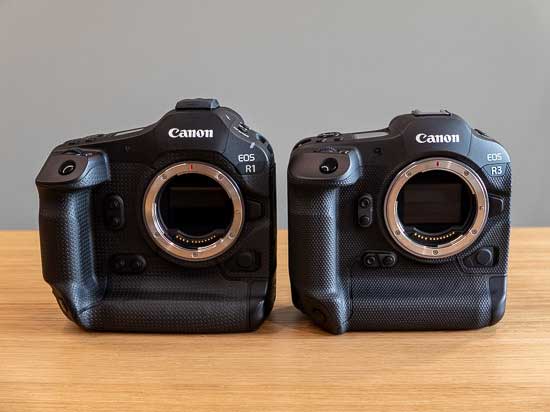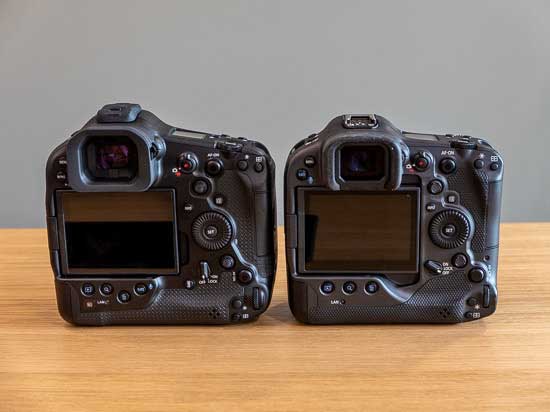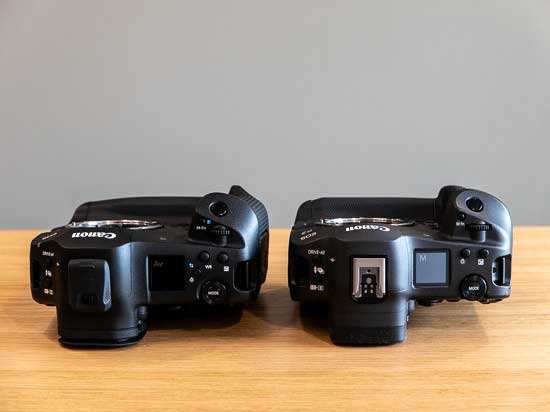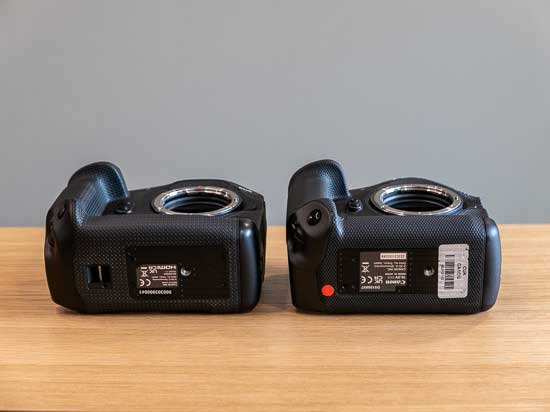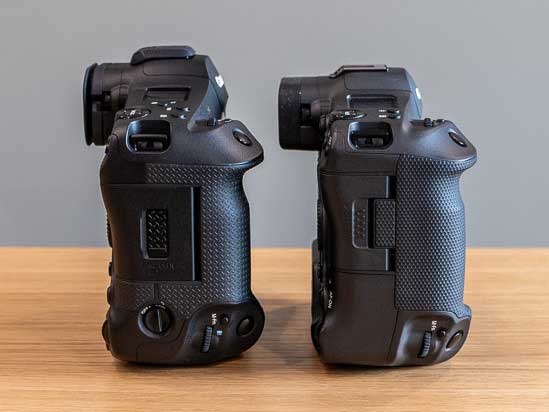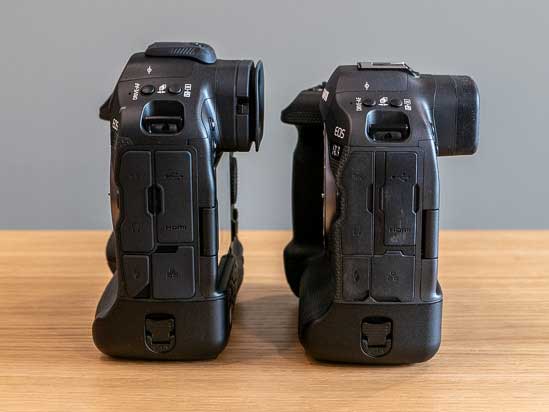
The Canon EOS R1 and Canon EOS R3 are both 24 megapixel full-frame mirrorless cameras that have a clear focus on providing as much speed as possible for sports and wildlife photography.
They share quite a lot of similarities when it comes to their core specifications and features, so which one should you pick?
We’re bringing you this Canon EOS R1 vs Canon EOS R3 head-to-head comparison to help you choose between these two full-frame cameras.
You can also read our detailed Canon EOS R1 review and Canon EOS R3 review to find out exactly what we think of each one in much more depth.
Sensor
Both of these cameras offer very similar megapixel counts and use very different sensor technologies.
The Canon EOS R1 has a brand new 24.2 megapixel full-frame back-illuminated stacked CMOS sensor with a 16 point low-pass filter.
The EOS R3 also uses a stacked back-illuminated sensor, just like the one on the R1, with similar 24 megapixel resolution.
So both models have a stacked CMOS sensor with integral memory, which delivers faster performance and much faster burst speeds than cameras without.
Back-Side Illuminated (BSI) sensors potentially translate into better low-light image quality at like-for-like ISO speeds and faster all-round performance.
Processor
The EOS R3 uses the latest DIGIC X processor, whereas the R1 has the DIGIC X processor paired with a brand new DIGIC Accelerator processor.
The new ‘Accelerated Capture’ dual processor imaging platform on the EOS R1 supports the processing of large volumes of data, alongside Deep Learning technologies. In turn this unlocks higher performance and improved auto focusing, continuous shooting and image quality.
ISO Speed
The native ISO range of the Canon R3 runs from 100-51200, which can be further expanded down to ISO 50 and up to ISO 102400.
The native ISO range of the Canon R1 is slightly wider, running from 100-102400, which can be expanded down to ISO 50 and up to 204800.
On the R1 only, in-camera upscaling can enlarge up to 4x the initial resolution with no degradation in quality, while deep learning noise reduction can reduce noise by 2 stops.
Video
The key video specs for the Canon R1 are 6K 60p RAW in-camera, 4K 120p, 4K 60p oversampled from 6K, and 2K or Full HD at 240p in XF-HEVC S / XF-AVC S formats.
It offers 16+ stops of dynamic range, minimal rolling shutter, Canon Log-2 / Log-3 / HLG profiles, custom pictures, proxy movie support and 4-channel 24-bit audio.
The EOS R3 also offers 6K/60p internal recording in addition to oversampled 4K video at up to 120p. It supports 10-bit 4:2:2 DCI 4K video at up to 60fps.
The R3 supports unlimited recording times with no overheating, allowing up to six hours of normal video or 90 minutes of full HD high frame-rate footage to be captured, and it features mic and headphone ports and a micro-HDMI Type-D port for output to an external recorder.
Autofocus
The Canon R3 has the most advanced version of Dual Pixel CMOS AF that the company has ever produced with 4779 AF points, along with a vehicle tracking mode, which allows you to expertly track motorbikes, open cockpit Formula cars as well as GT and rally cars, and even has the ability to prioritise the vehicle or the driver’s helmet!
The Canon R3 also allows you to select and move the AF point just with the look of your eye using the electronic viewfinder. This gives the R3 a real edge when it comes to quickly being able to focus, without even having to touch the camera controls.
The new Dual Pixel Intelligent AF system featured on the R1 offers an advanced tracking algorithm that can detect subject crossing/upper half of body and avoid obstacles by estimating the head area.
The new Action Priority subject tracking mode uses deep learning tech for football, basketball and volleyball to detect where the action is and move the AF point to that subject at up to 60fps. It can quickly detect and identify multiple people, status of joints and ball positions and automatically determine the main subject and action poses, depending on the sport.
Subject tracking can now recognise horses, aeroplanes and trains in addition to people, animals and motorsport vehicles when shooting both photo and videos.
The Registered People Priority mode can detect and prioritise up to 10 faces even in side profile, useful for sports, news and weddings, with the ability to save 10 files on a memory card each with 10 registered faces.
The R1’s eye control AF feature lets you select focus points or subjects to track simply by looking at them in the electronic viewfinder.
Compared to the R3 model on which this feature first made its debut, eye control AF on the R1 offers improved performance thanks to a higher pixel count sensor, improved LEDs, larger eye detection area, an updated detection algorithm, and 2x faster eye movement detection speed.
Burst Shooting
The Canon R3 provides 30fps shooting with the electronic shutter with full AF/AE tracking and minimal image distortion for 540 JPEG or 150 RAW images.
Burst shooting speeds on the EOS R1 are rated at 40fps continuous shooting with the electronic shutter or 12fps with the mechanical shutter.
Pre-continuous shooting up to 20 frames (Raw or JPEG/HEIF) is also newly available before fully pressing the shutter button.
Shutter Speed
Both cameras have a very fast maximum shutter speed of 1/64,000th second thanks to their electronic shutters.
Body
Both cameras feature a similar integrated vertical grip design with duplicated vertical controls that EOS-1D series DSLR cameras have always offered.
Both are also fully weather-sealed, as you’d expect from such professional level models.
The R3 is slightly smaller and lighter than the R1.
The EOS R3 weighs in at 822g body-only or 1015g with both a battery and memory card fitted and measures 150 x 142.6 x 87.2mm.
The EOS R1 weighs in at 920g body-only or 1115g with both a battery and memory card fitted and measures 157.6 x 149.5 x 87.3 mm.
Viewfinder
The R1 has a better viewfinder than the R3 – a 9.44M-dot OLED electronic viewfinder with 0.90x magnification and a refresh rate of up to 120fps.
The Canon R3 has a lower-resolution 5.76M-dot OLED electronic viewfinder with 0.76x magnification and a 120fps refresh rate.
LCD Screen
The EOS R3 has a very well-specced 3.2-inch, 4.15 million dot, vari-angle LCD screen which tilts out to the side and faces forwards for more convenient vlogging and video recording.
Rather strangely, the newer and more expensive EOS R1 only has a 3.2-inch LCD panel with 2.1 million dots of resolution. It’s a similar articulating screen that can be flipped out to the side, rotated to the front, and folded against the back of the camera to help protect it.
IBIS
Both cameras have 5-axis optical in-body image stabilisation that corrects for pitch and yaw shake.
The Canon EOS R3 has a 5-axis In-Body Image Stabilizer that can combine with the Optical Image Stabilizer in selected RF lenses to offer industry-leading performance worth up to 8-stops
The R1 is even slightly better again, offering up to 8.5-stops of image stabilisation.
Memory Cards
The Canon R3 features dual card slots, one SD UHS-II slot and one ultra-high speed CFexpress Type B slot.
The Canon R1 also has dual slots, but both of them are ultra-high speed CFexpress Type B slots.
Battery Life
Both cameras use the LP-E19 series battery, which provides up to 620 shots when using the viewfinder and 860 shots when using the LCD monitor on the R3 and up to 700 shots when using the viewfinder and 1330 shots when using the LCD monitor on the R1.
Both cameras can also be powered and charged via a USB connection, which is useful if you’re out and about and have a compatible powerbank to plug the camera into, and both use the newer USB-C variant.
Price
The Canon EOS R1 is priced at £6999 body only in the UK and €7999 in Europe.
The Canon EOS R3 was priced at £5799 in the UK and $5999 in the US when it launched in late-2021.
Conclusion
Choosing between the new Canon EOS R1 and the Canon EOS R3 really comes down whether or not you’ll benefit from the former’s dual processor technology and the subsequent improvements to auto focusing, continuous shooting and image quality, as otherwise they’re very evenly matched.
So what do you think? Would you choose the slightly older and cheaper EOS R3 or the newer, more expensive EOS R1? Leave a comment below!
Your Comments
Credit : Source Post

